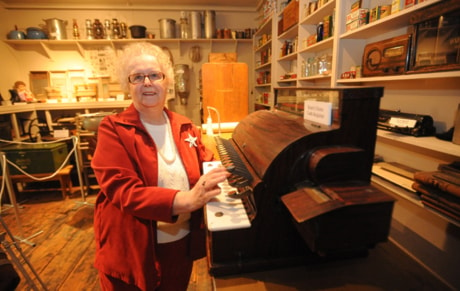INNISFAIL — The first day of business at George Washington West’s general store went well on that summer July 1st day in 1891.
He sold five pounds of apples at 25 cents a pound and four pounds of brown sugar went out the door for another 36 cents.
And then a Mr. Miller came in to check out Innisfail’s first store. He walked away with a red handkerchief, according to a ledger preserved at Innisfail Historical Village. Once-mundane entries in an account book now offer a fascinating glimpse into life in rural Central Alberta, many years before the province got its name.
The ledger and dozens of other historical items are located in a general store mock-up created as part of a 40th anniversary project by the Innisfail and District Historical Society to restore the village’s 1904 Bowden CPR rail station and update its exhibits.
George Washington West was Donna Chadwick’s grandfather and her family ran that store in Innisfail until Christmas Eve 1968, an unbroken 77-year run.
Many of the items in the store came from her collection, including the sales ledger, so carefully preserved in oilskin that the pages remain white 109 years later.
Her grandfather was a teacher when he moved out West from Prince Edward Island. He followed the railroad as it creaked from Calgary to Innisfail, lurching north so slowly that he got out and walked much of the way.
When he reached the end of the line, he found a small farming community until recently known as Poplar Grove that had no general store. George Washington — the reason for the salute to American patriotism a family mystery — decided to change that.
A sepia-coloured photo survives showing a space crowded with tins, boxes, tack, tools, a large pickle barrel and hundreds of other turn-of-the-century household essentials.
Chadwick points to an alcove lined with shelves almost hidden in the corner of the picture. “Up here there was a pail. Any cash they had — which wasn’t much — they put it in the pail.”
Most sales were bartered. A chicken here for some oats there. Eggs for sugar, and so on. It didn’t matter to her grandfather.
“He didn’t let anybody go hungry.”
West, known to all as G.W., soon became the conduit to get goods from farms in the area to markets as far south as Texas. In one memorable deal, he bartered two train carloads of frozen jackrabbits for meat and other groceries from meat packing magnate Pat Burns, the man behind the P. Burns & Co., later Burns Foods.
Originally built on the north side of the tracks, the store was moved to the south when the railroad decided to move the town. It eventually sat across from the present theatre, where an Alberta Treasury Branch now sits.
Chadwick, who was born in Innisfail in 1928, remembers well working in the store. At one time, the family business had included a fur exchange and a lumber yard. But as times changed, so did the store. It became more of a department store offering full lines of men’s, women’s and children’s fashions.
When the business closed, its history was thankfully not lost. A cash register, scale, cheese cutter, cheque-making machine, poster maker and other tools of the trade had been squirreled away.
“My dad was a keeper and so was I,” she said.
Now, those items have been preserved at the train station, which was moved to Innisfail in 1976 to save it from demolition.
When the store finally closed, people from farms and small communities all over Central Alberta made their way into town to make one last purchase.
“It really was an institution is what you would call it now.”
And of the hundreds of sales made that day, she still recalls there was not a single NSF cheque.
pcowley@www.reddeeradvocate.com
